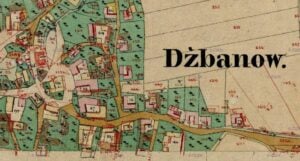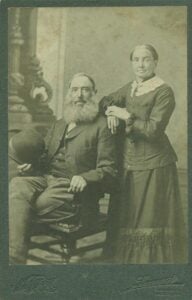A few years ago, I stumbled on an amazing resource: the Zamrsk Regional Archive in the Czech Republic. This archive, which manages records from the region of Eastern Bohemia, has been working on digitizing all of the church register books in its collection and making them available for free through their website. All you need to use them is a little patience and a lot of free storage space on your computer.
My maternal grandfather is a half-Norwegian, half-Czech Midwesterner. I grew up hearing stories about my Norwegian ancestors, but not so many about my Czech relatives. However, we were lucky enough that the name of the family’s hometown in the Czech Republic (then Bohemia and a part of the Austro-Hungarian Empire) got passed down to my generation. My grandfather’s grandparents immigrated separately to Wisconsin in the 1870s and 1880s, where they met and married. Using the church register books available from the Zamrsk Archive, I was able to take that side of my family back three more generations.
The Zamrsk Archive’s website can be confusing and overwhelming, though it does contain some instructions in English. Each church register book (Matriky) must be downloaded in its complete form as a zip file, which you then unzip and browse through until you find the record you’re after. Many of the church books are indexed, making locating records even easier. Unfortunately, as the inventory with associated links is in PDF form, each time it gets updated the URL to access the inventory file changes. So much for saving it as a bookmark! (I speak from experience…)
Though the books are organized at the parish level, the inventory always lists which particular villages appear in each book if there are deviations from the parish boundaries. This makes it easy to search the PDF document to find your ancestral village, though diacritical marks can throw a wrench into this strategy. The inventory itself is an impressive document. Its most recent iteration (from August 2019) is over 2,600 pages long, and lists church registry books that date from 1587 to 1949. Catholic records make up the bulk of the collection (about 2,440 pages of the inventory), while Evangelical church records make up the remainder. Items with no blue, linked zip file have not yet been digitized but should be coming soon.
Like most other church registers – no matter their place of origin – the Czech registers are organized by birth, marriage, and death for the most part, though earlier records are lumped together. Occupations and places of residence are typically recorded. Unlike our street addresses of today, the traditional Czech system was for each house to get a number, and those numbers were not based on location. So while “Dzbanov 71” might not seem like a specific address, it does in fact refer to house #71 in the village of Dzbanov, which can be found on a contemporary cadastral map (located between houses 70 and 88, and in front of house 72). These cadastral maps are not part of the Zamrsk Archive’s website, though they can usually be found elsewhere.
Unlike our street addresses of today, the traditional Czech system was for each house to get a number, and those numbers were not based on location.
For me, a deep dive into the church books at the Zamrsk regional archive results in twenty-five new direct ancestors over three new generations, as well as dozens of collateral ancestors like siblings, nieces, and nephews. Undertaking research in a language you don’t read or speak is certainly intimidating and challenging. But the more records you look at, the easier it gets. And in the end, the payoff is new branches of your tree!
A current version of the Zamrsk Regional Archives online inventory can be found by going to https://stare.vychodoceskearchivy.cz/zamrsk/ and clicking the purple hyperlink that read "seznam matrik, z něhož lze stahovat jednotlivé digitalizované matriční knihy." Using a built-in browser translator is recommended.
FamilySearch has put together an incredibly helpful genealogical word list, which gave me the skills to decipher some of the occupations (gravedigger, peasant, smith) and causes of death that I encountered throughout the register. It can be found at https://www.familysearch.org/wiki/en/Czech_Genealogical_Word_List.
A guide to understanding and locating Czech cadastral maps can be found online at http://czechgenealogy.nase-koreny.cz/2014/07/stabile-cadaster-maps.html.
Share this:

About Hallie Kirchner
Hallie Kirchner is a genealogist and part of the team that performs research-for-hire for patrons. In addition to working with patrons to answer their family history questions, Hallie also helps with the Ask-A-Genealogist chat service and has worked on a variety of educational programs during her time at American Ancestors. Her areas of expertise include 19th-century America, Germany, and immigration.View all posts by Hallie Kirchner →

